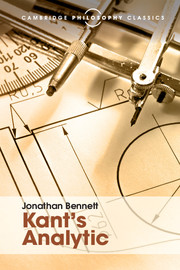Book contents
10 - Schematism
from Analytic of principles
Published online by Cambridge University Press: 05 July 2016
Summary
Concepts and schematism
The first chapter in the Analytic of Principles is called ‘The Schematism of the Pure Concepts of Understanding’. In it Kant tries, by means of a general theory about how any concept is applied to its instances, to solve an alleged problem about the application of the categories in particular. He may not have intended to offer a general theory: it may be that, starting with his problem about the categories, he just drifted into saying about every concept what he initially intended to say about the categories alone. But I shall provisionally take it that the general theory is there in its own right, and not merely as a by-product of the problem about the categories.
Kant seeks to answer the following suspect question: ‘Given that I possess a concept, how can I apply it to its instances?’ His answer, his general theory of concept-application, says that a concept can be applied only with the aid of its schema, which is a ‘representation of a universal procedure of imagination in providing an image for a concept’. The nasty phrase ‘representation of a universal procedure’ just means ‘rule’. The schema of the concept of a dog is ‘a rule according to which my imagination can delineate the figure of a four-footed animal in a general manner, without limitation to any single determinate figure such as experience…actually presents.’ In fact, Kant says this about the concept of a dog rather than about that concept's schema. I shall explain later why.
Kant's theory of schemas—whether or not it ultimately works—does at least improve on most theories which link concepts with images. Instead of associating each concept with a single image, or with a set of exactly similar images, Kant's theory associates each concept with a rule for image-production. This, as he observes, saves him from a difficulty which is fatal to other theories. If the concept of a dog, for instance, is to be associated with a specific kind of image, what kind could it be? It cannot be spaniels, or dachshunds, or borzois; nor can it be, as Locke said on a related matter, all and none of these at once.
- Type
- Chapter
- Information
- Kant's Analytic , pp. 149 - 161Publisher: Cambridge University PressPrint publication year: 2016



